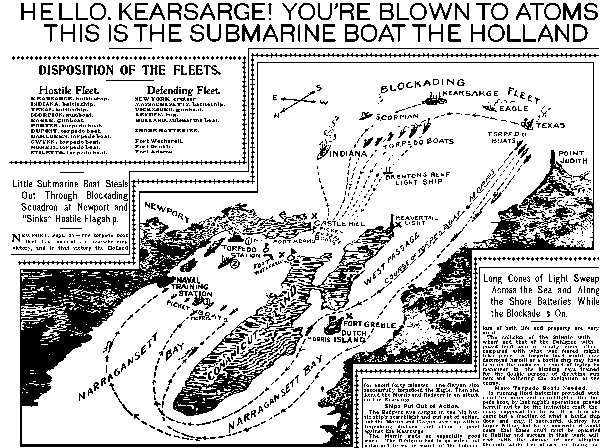

In his book John P. Holland: Inventor of the Modern Submarine, Dr. Richard Knowles Morris described the scene as follows:
"On sundown on the second night of maneuvers, USTB Holland slipped away from her dock at the Naval Torpedo Station and made her way through the passage east of Conanicut Island. Her course was set for a position east and south of Brenton Reef Lightship, from which point the search seaward began for the units of the blockading Red Squadron. It was one of those clear, cool nights when the sky is like velvet studded with brilliant stars, in marked contrast to the inky, undulating sea. The young lieutenant feared that under such atmospheric conditions the phosphorescent wake of his vessel might betray his presence. He brought her to a trim where only her turret and six inches of her hull remained above water. Somewhere in the darkness lay the battleships Kearsage, Indiana, and Texas, and the gunboats Scorpion and Eagle."
"About 9:00 P.M., already seven miles at sea, a huge shadow loomed ahead. Caldwell aimed the bow of the submarine directly at the object, his "kill" or torpedo tube opening taking a deadly aim at the outline. He flashed his warning signal. There was no response. He brought the Holland in closer to the slowly moving shadow of a ship and recognized her as Captain William M. Folger's flagship, the Kearsage. At one hundred yards from his target, the young lieutenant showed his light and proudly shouted: 'Hello, Kearsage! You're blown to atoms. This is the submarine boat the Holland.'"
"When the umpire for the games added up the "casualties" among the ships of the blockading Red Squadron, there was some doubt about the Holland's score on the technical grounds that the Kearsage had already been "knocked out" by the surface torpedo boats Morris and Gwynn, also units of the defending fleet."1
In a letter dated January 12, 1901, Lieutenant H.H. Caldwell writes:
"The 'Holland' was under my command on the occasion mentioned. She left the Torpedo Station at sundown and was placed in a partially submerged condition with the turret and about six inches of the hull above water, ready to dive at short notice. Cruised in this condition to S'd and E'd of Brenton's Reef Lightship. Sighted two vessels of blockading fleet and firing torpedo signal at them, but was not answered, and they disappeared before I could ascertain their identity. About 9 p.m., about seven SSE. from harbour entrance, sighted U.S.S. 'Kearsage' within range and fired torpedo signal. Followed her and getting within 100 yards without being discovered, showed light, hailed her and informed her commanding officer that she had been torpedoed. The 'Holland' was not seen by any vessel of the blockading fleet or torpedo boat, although she was within range of three of the former and several of the latter. I consider that the attack was a success because the 'Holland' could in all probability have torpedoed three blockading vessels without being discovered."2
In a report of the Commanding Officer of the U.S.S. Kearsage:
"It is clear that the 'Holland' type will play a very serious part in future naval warfare. There is no doubt whatever that the vessel at Newport can approach a turret ship unseen, either by night or day. Her only danger is she may be run over herself by picket or large vessel."3
In a report of Commander-in-Chief, North Atlantic Station:
"The 'Holland' impressed everyone with the idea that under ordinary circumstances she could always get in a torpedo, either day or night, without being discovered. Unfortunately, in her attack upon the 'Kearsage,' the second night, she did not reach there until several torpedo boats did, so that so strict a look-out was probably not being kept as would otherwise have been."4
ÓCopyright 1999,2000,2001,2002 Gary McCue